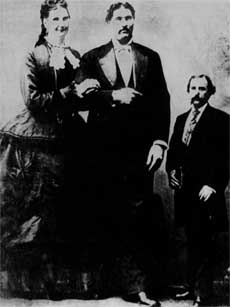![]()
|
|
|
|
|
|||||

Success Stories
 Anna
Swan: Nova Scotia’s Remarkable Giantess
Anna
Swan: Nova Scotia’s Remarkable Giantess
Life story of a famous Canadian Giantess
In August 1846 the towns of Truro and Pictou, Nova Scotia were abuzz with spectacular news. A giant baby, weighing more than 18 pounds, had been born in the nearby farming community of New Annan. Within days, word of the birth spread across the province and down the Atlantic coast to Boston. It was the beginning of a lifetime of notoriety for Anna Swan, Canada’s world-famous giantess.
At the age of 17, Anna had not yet completed her studies to be a teacher when showman P.T. Barnum persuaded her to join his Greatest Show on Earth in New York City. At almost eight feet tall, she was billed as “The Tallest Woman in the World” and became a star attraction. Barnum was impressed with the young woman’s poise and intelligence and agreed to her request for private tutoring to continue her education.
Anna traveled across Europe and North America with Barnum’s show, receiving rave reviews for her singing, piano playing, and dramatic performances, which included a stint as Shakespeare’s Lady Macbeth. She gave public lectures on the cause of giantism and, at the peak of her fame, met Queen Victoria, who was impressed with her stateliness and composure.
Anna later married famous American giant Martin Bates, who at 7‘9’’, would often joke that he had to place two-inch lifts in his shoes to look his wife in the eye. The couple settled into a custom-built, giant home in Seville, Ohio, where Anna taught Sunday school. She died in Seville of tuberculosis, one day before her 42nd birthday, in 1888.
While Anna Swan was famous for her size, she charmed royalty and public alike with her graceful manner and engaging personality and was renowned for sharing generously the rewards of fame with family, friends and community. More than a century after her death, Anna Swan’s life and legacy are remembered in a small museum and archives housed in the Northumberland Arts Council’s Fraser Cultural Centre in Tatamagouche, Nova Scotia, less than 10 kilometers from her birthplace.
With the goal of sharing this legacy with other Canadians, Debra Hoffos of Tatamagouche’s North Shore Community Development Association, applied to the Canada’s Digital Collections program for funding to digitize the museum’s Anna Swan Collection and make it available on the Internet. The CDC program, funded by the Youth Employment Strategy, enable young Canadians aged 15 to 30 to gain work experience converting valuable Canadian material such as the Anna Swan Collection for display on the Information Highway.
After successfully completing CDC’s competitive application process, Hoffos received funding to hire three youths to carry out the digitization project. The students immediately set to work on all aspects of building a Web site including research, content creation, imaging, Java scripting and HTML coding.
Much of the initial work involved digitizing, and in some cases digitally restoring 19th century photos from the Anna Swan Collection. This work was accompanied by the creation of a detailed chronology of Anna’s life based on sources provided by Tatamagouche’s North Shore Archives and on material provided by local high school teacher Dale Swan, Anna’s great-great nephew.
In working together, Hoffos says the youth developed innovative ideas for making the Web site fun and educational for people of all ages. Those ideas include an easy-to-read story book version of Anna Swan’s life for younger children, a series of interactive games, a glossary of 19th century terms and a historical section describing life in Tatamagouche in the 1800s. “The youth project team worked well together, showing a lot of initiative and creativity,” says Hoffos. “Their efforts went far beyond my expectations.”
The team’s youngest member, 16-year-old Ashley Cunningham says the project gave her a chance to learn graphic design software, which she used to create the colourful, cartoon-like images that fill the popular children’s story book of Anna Swan’s life. “The project was a great opportunity for me,” says Cunningham, adding that the research, teamwork and computer experience give her a leg up on future employment opportunities.
Teacher Dale Swan, whose family photos, artifacts and memorabilia make up the bulk of the Anna Swan Collection, worked closely with the students during the three month project. He says he is delighted with the result. “Anna was a warm, kind and intelligent human being,” observes Swan. “This site really reflects her personality and treats her with the dignity and respect she deserves.”
Swan says his great-great aunt would have approved of the site’s message of compassion and tolerance for all people, regardless of their appearance. “Anna trained to be a teacher,” he reflects. “Through this collection I think that, in her own way, she is still teaching.”
Visit the Canada's Digital Collections World Wide Web Site at http://collections.ic.gc.ca
|
Updated: |